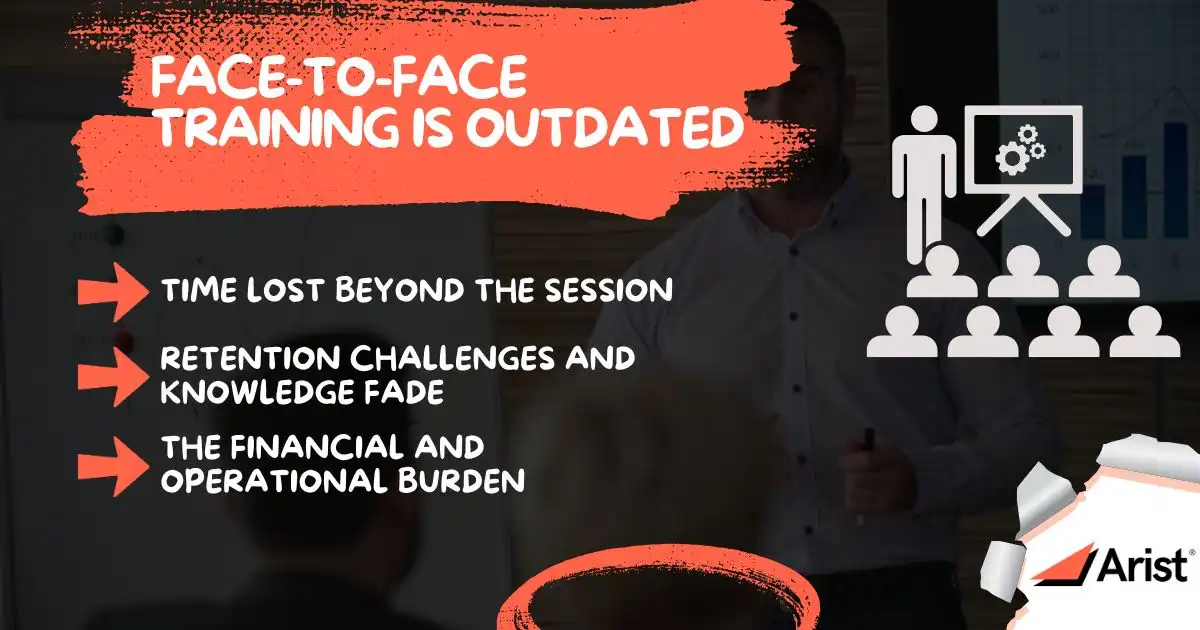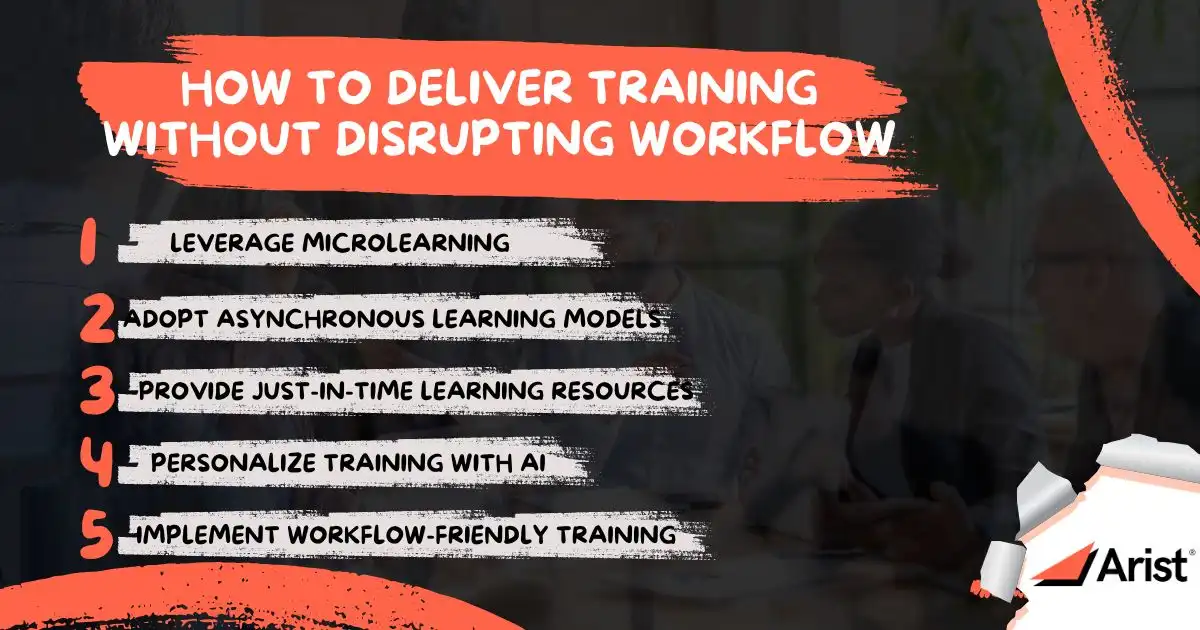Delivering a Good Training Session Without Disrupting Workflows
Time is one of the most valuable assets for employees. Every hour spent in lengthy training sessions is an hour away from tasks directly contributing to business growth. While learning and development remain critical, the old in-person training model is increasingly considered inefficient, costly, and ineffective. Not only does it drain productivity, but information overload often leads to poor retention, meaning much of the content is forgotten soon after the session ends.
So, why not rethink the way we train? We need a solution that allows employees to learn without stepping away from their desks, allowing them to stay productive while engaging in meaningful development. Integrating training into their daily workflow can minimize disruptions and maximize impact, empowering teams to grow their skills without sacrificing valuable work hours.
Face-to-Face Training Is Outdated and Costing You Productivity

Face-to-face training has long been regarded as a pillar of corporate learning, offering structured environments for skill development and professional growth. While the intention behind these sessions is commendable, the reality often tells a different story. Instead of enhancing productivity, traditional in-person training frequently interrupts workflows, creating ripple effects that extend far beyond the training room.
Time Lost Beyond the Session
On the surface, dedicating a day or two to employee training seems reasonable. However, the time spent on these sessions extends well beyond the scheduled agenda. Preparing materials, organizing logistics, and managing follow-ups contribute to time consumption. Employees often face a backlog of tasks, emails, and missed deadlines once they return to their desks. The effort required to regain momentum can far outweigh the benefits of the training itself. This cycle of disruption gradually slows productivity, often without tangible long-term gains.
Retention Challenges and Knowledge Fade
The effectiveness of training isn't determined by attendance alone. Research indicates that learners forget nearly 70% of new information within 24 hours of training without follow-up or reinforcement. This isn’t a reflection of employee engagement but a natural consequence of cognitive overload. Long, dense sessions inundate employees with information, leaving little room for absorption and application. As a result, much of the knowledge acquired during face-to-face training is forgotten before it can be put to practical use. Without periodic reinforcement, the initial investment in these sessions often fails to translate into lasting skill development.
The Financial and Operational Burden
Beyond the immediate costs of venues, travel, and external facilitators, the hidden financial impact of face-to-face training lies in lost productivity. Every hour spent in a training session diverts from core business activities—sales calls go unanswered, project milestones are delayed, and clients experience slower response times. This collective downtime across departments can accumulate rapidly, presenting a significant yet overlooked cost to the organization. Compounding this issue is the difficulty in measuring the direct return on investment (ROI) of traditional training, making it challenging for businesses to justify the expense.
Workflow-Integrated Training (LIFOW) Is the Future of Corporate Learning

Traditional training models often clash with daily work demands. Learning in the Flow of Work (LIFOW) bridges this gap by embedding training directly into employees' tasks, ensuring learning happens naturally without disrupting productivity. This method shifts from long, isolated sessions to on-demand microlearning, seamlessly fitting into existing workflows. As hybrid and remote work environments grow, delivering knowledge at the point of need becomes vital for staying competitive.
LIFOW provides timely solutions to common training challenges by:
Delivering on-demand learning – Employees access short, focused lessons exactly when needed, reinforcing skills during tasks.
Reducing disruption – Training is integrated into daily workflows, eliminating the need to pause critical work for lengthy sessions.
Boosting retention – Applying knowledge immediately helps employees retain information longer by reinforcing real-time concepts.
Enhancing engagement – Employees feel supported without the pressure of stepping away from work, fostering continuous learning.
Scaling easily – LIFOW adapts to remote, hybrid, and distributed teams, allowing companies to deliver consistent training globally.
Improving productivity – Employees remain focused on their core responsibilities by keeping training lightweight and relevant.
Companies implementing LIFOW have reported faster onboarding, higher employee satisfaction, and stronger engagement. For example, leading tech firms now leverage tools like Slack or Microsoft Teams to deliver microlearning directly to employees, ensuring they learn without leaving their workflow.
How to Deliver Training Without Disrupting Workflow

1. Leverage Microlearning for Maximum Flexibility
Microlearning platforms break down training into short, digestible lessons that fit the workflow. Instead of lengthy seminars, employees receive targeted content through quick reads, short videos, or interactive tasks. This ensures learning happens in bite-sized increments, minimizing disruption while consistently reinforcing knowledge.
Platforms like Arist deliver training via SMS, Slack, and Microsoft Teams, allowing employees to access lessons directly through the tools they already use.
2. Adopt Asynchronous Learning Models
Not all employees can participate in training at the same time. Asynchronous learning allows team members to engage with content on their schedule, removing the need to pause work for live sessions. This flexibility reduces scheduling conflicts and ensures employees can learn independently without missing deadlines.
Asynchronous models empower remote and global teams to access the same high-quality content, ensuring consistency across locations.
3. Provide Just-in-Time Learning Resources
Training is most effective when it’s immediately applicable. Just-in-time learning offers resources at the point of need, directly aligned with employees' tasks. This allows workers to solve problems on the spot, reinforcing skills and boosting productivity without interrupting their workflow.
Embedding training materials into CRM systems, communication platforms, or project management tools ensures that employees have access to knowledge exactly when needed.
4. Personalize Training with AI
AI-driven platforms analyze employee performance, identifying knowledge gaps and recommending tailored content. This personalization ensures that each employee receives the proper training, focusing on areas that need improvement without redundant lessons.
AI can adapt lessons based on real-time feedback, keeping training dynamic and responsive to evolving business needs.
5. Practical Steps to Implement Workflow-Friendly Training
Identify Core Training Areas: Focus on essential skills that can be delivered in smaller, focused modules. Prioritize content that directly impacts employee performance.
Choose the Right Tools: To reduce friction and improve engagement, select platforms that integrate with existing communication tools, such as Slack, Teams, or email.
Track and Measure Impact: Use analytics and engagement data to monitor employees' interactions with training. Evaluate retention rates and performance to measure ROI and adjust content as needed.
Gather Feedback Continuously: Encourage employees to provide feedback on training materials. Use this insight to refine and enhance the content, ensuring it remains relevant and impactful.
Rethink Training to Drive Growth Without Disruption
Traditional training methods no longer meet the high-demand nature of today’s workplace. While employee development is essential, the approach must evolve to minimize workflow disruptions and enhance productivity. With Arist’s microlearning and workflow-integrated training solutions, businesses can equip their teams with the necessary skills without distracting them from critical tasks or slowing momentum.
Arist delivers learning directly through platforms employees use, such as Slack, SMS, and Microsoft Teams. This ensures that training fits seamlessly into their daily routines, fostering engagement and driving measurable performance improvements.
👉 Transform your L&D programs with Arist. Explore how Arist’s AI-driven microlearning solutions can empower your workforce and unlock their full potential without disrupting the flow of work.
Arist Team
Bring
real impact
to your people
We care about solving meaningful problems and being thought partners first and foremost. Arist is used and loved by the Fortune 500 — and we'd love to support your goals.
Curious to get a demo or free trial? We'd love to chat:


